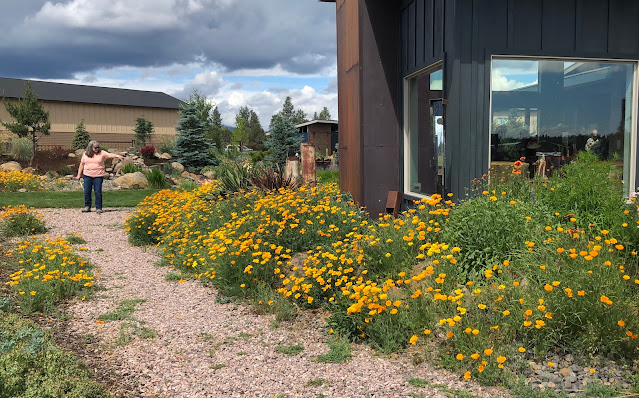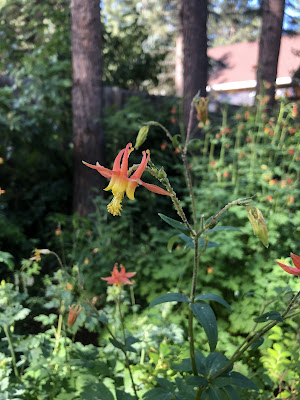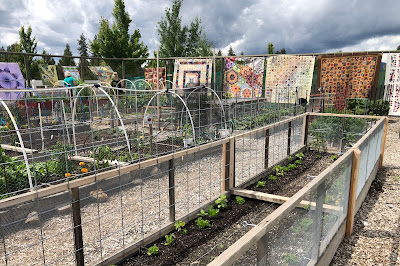
Visiting gardens in central Oregon for fun and education

|
| California poppies put on a show in this Sisters, Ore., garden. (Photos: Kathy Morrison) |
The house was not far from the local airstrip, but with a stunning view of mountains still wearing a white cap of snow. The walls and fences for this special event were hung with intricate quilts, most of modern design. Garden decor include many freestanding pieces by the owner, a metal sculptor. The whole site appealed to my collective creative delights.
But I was surprised — and then amused to be surprised — when I turned a corner into the garden and saw the huge bank of blooming California poppies ( Eschscholzia californica ). Wait, part of my brain said, why are homeowners in central Oregon growing California’s state flower?
Because, of course, they can.
It was a good reminder that the West Coast states are linked botanically. (Most of my poppies are long dead, pulled out about a month ago.) The gardens we visited around Sisters, Ore., this week proved more intriguing to me than the quilts hung there — though the quilts were indeed lovely.
The fundraising self-guided tour was presented by the Sisters Garden Club, the first time since 2019 the gardeners have been able to schedule it.

|
|
Western columbine in bloom.
|
Very few tomatoes were evident in the vegetable gardens, and the one basil I spotted was in a pot, protected from deer by chicken wire.
We also were able to visit the local community garden, another quilt display site. I zeroed in on the plots, which were about 4-by-12-feet. Many had small fences or even cages over the soil, and I asked one of the gardener hosts why.
“Sage rats,” she said with a tone of disgust. “And mice. We were hit really bad last year. This year’s better so far, but …” She looked out over the garden. “Last year my garden was eaten to the ground, like someone took a lawnmower to it.”

|
| The Sisters community garden, with quilts. |
And here I was envying the Sisters weather. (It rained here twice this week.) Sacramento gardeners do complain about the scorching heat, but at least we’re not battling sage rats!
Comments
0 comments have been posted.Sacramento Digs Gardening to your inbox.
Sites We Like
Garden Checklist for week of May 12
Get your gardening chores and irrigation done early in the day before temperatures rise.
* Plant, plant, plant! It’s prime planting season in the Sacramento area. Time to set out those tomato transplants along with peppers and eggplants. Pinch off any flowers on new transplants to make them concentrate on establishing roots instead of setting premature fruit.
* Direct-seed melons, cucumbers, summer squash, corn, radishes, pumpkins and annual herbs such as basil.
* Harvest cabbage, lettuce, peas and green onions. This heat will cause leafy greens and onions to flower; pick them before they bolt.
* In the flower garden, direct-seed sunflowers, cosmos, salvia, zinnias, marigolds, celosia and asters.
* Plant dahlia tubers. Other perennials to set out include verbena, coreopsis, coneflower and astilbe.
* Transplant petunias, marigolds and perennial flowers such as astilbe, columbine, coneflowers, coreopsis, dahlias, rudbeckia and verbena.
* Keep an eye out for slugs, snails, earwigs and aphids that want to dine on tender new growth.
* Feed summer bloomers with a balanced fertilizer.
* For continued bloom, cut off spent flowers on roses as well as other flowering plants.
* Got fruit trees? If you haven't already done so, thin orchard fruit such as apples, peaches, pears, pluots and plums before they grow too heavy, breaking branches or even splitting the tree. Leave the largest fruit on the branch, culling the smaller ones, and allow for 5 to 6 inches (or a hand's worth) between each fruit.
* Thin grape bunches, again leaving about 6 inches between them. For the remaining bunches, prune off the "tail" end, about the bottom third of the bunch, so that the plant's energy is concentrated in the fruit closest to the branch.
* As spring-flowering shrubs finish blooming, give them a little pruning to shape them, removing old and dead wood. Lightly trim azaleas, fuchsias and marguerites for bushier plants.
* Add mulch to the garden to help keep that precious water from evaporating. Mulch also cuts down on weeds. But don’t let it mound around the stems or trunks of trees or shrubs. Leave about a 6-inch to 1-foot circle to avoid crown rot or other problems.